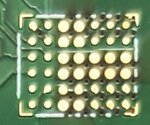rayhh27
Member level 1

Hi,
I am intending to design PCB using BGA IC, I am wondering whether is it not good if I use polygond copper right beneath the BGA package? Why?
Thank you.
Best regards,
RH
I am intending to design PCB using BGA IC, I am wondering whether is it not good if I use polygond copper right beneath the BGA package? Why?
Thank you.
Best regards,
RH


